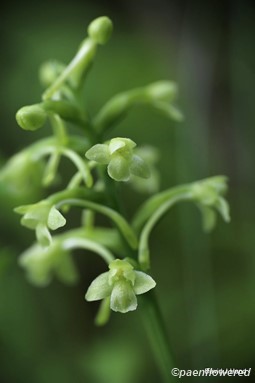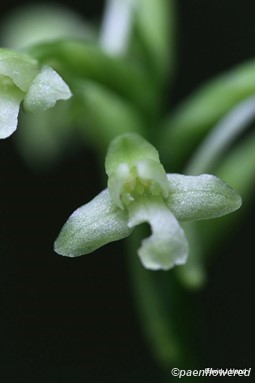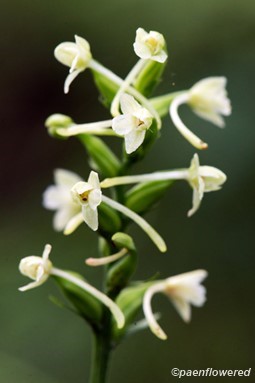Platanthera clavellata
Platanthera clavellata club spur orchid
Add to MyPlants View Locations
This perennial member of the orchid family grows about 6-18 inches tall, including the flowering stalk. The central stalk is light green with a single prominent clasping leaf near the bottom. This leaf is usually 2-6 inches long and has conspicuous veins. Above this leaf the alternating leaves are much reduced in size, essentially bracts.
The flower cluster is 0.75 to 3 inches long and has between 5-20 greenish white flowers. The flowers may be nodding or pointed upwards and are often twisted to the sides. Each bloom is only about 1/3 to ½ inch long. There are 3 greenish white petals and 3 sepals that have the appearance of petals. The ovary is green. The two upper petals and upper sepal form a hood. The two lateral sepals project forward to form “wings”. The lower petal forms a lip with 3 small lobes and a long nectar spur that is about ½ inch long with a slightly swollen tip. Little is known about the process of pollination, but the long spur would suggest moths are the primary insect agents. These long nectar spurs may overlap each other on the cluster. When in full bloom the flowers of this delicate orchid can be quite pretty. The blooming period is June through September (depending on location) and occurs over a period of 2-3 weeks. If not pollinated, the flowers may self-fertilize. There is a faint fragrance.
The fruit is a capsule that eventually splits to release a large number of tiny seeds. The species is also called the small woodland orchid or the small green wood orchid, but is found not only in wet woodlands but also in bogs and along shorelines. It grows throughout the eastern half of North America in the proper environment. In Western Pennsylvania it is historically documented in the far northern counties and in Greene, Fayette, Westmoreland and Somerset counties. This orchid does not transplant well so, like most wildflowers, should be left in its place. Even if grown from seeds, it may require soil in which the proper symbiotic fungus is growing.
Habitat & Range
Grows in bogs, wet woods, and thickets.
Present throughout the state and is frequent.
Range: Throughout the eastern half of North America
| EMP: | FACW |
|---|---|
| NCNE: | FACW |
Phenology
Flowers from June to September.
Plant Codes
S-rank: S5 (Secure)
G-rank: G5 (Secure)
Platanthera clavellata club spur orchid
Synonyms: Habenaria clavellataAdd to MyPlants View Locations















Comments
Have you spotted this plant in your area? We'd love to hear about your experience! Share your comments or questions about the plant below. Comments are moderated before posting.